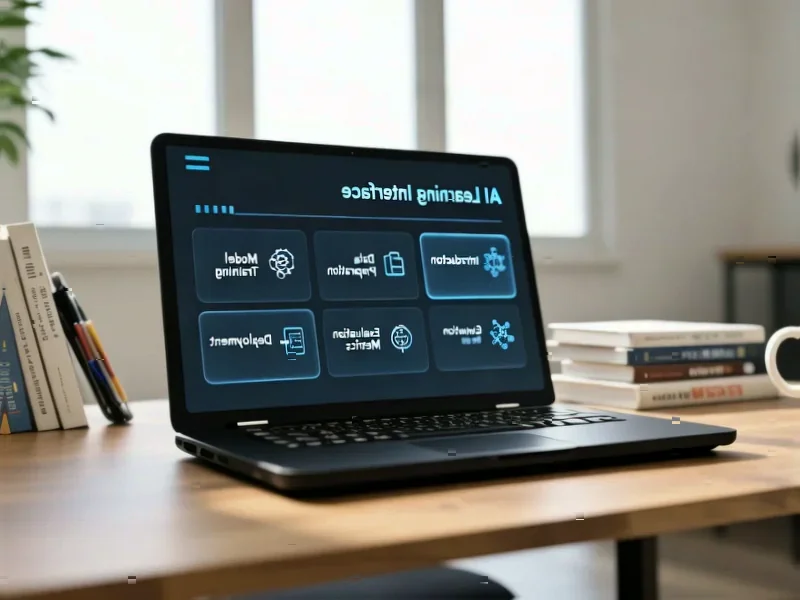According to Financial Times News, Pearson CEO Omar Abbosh believes AI will enhance rather than replace human teachers, positioning the 181-year-old education company at the forefront of technological transformation in learning. Since taking leadership in early 2024, Abbosh has focused on driving commercial intensity in a company he describes as “thoughtful, academic, collaborative” but not necessarily “the most intense commercially.” Pearson’s research suggests inefficient career pathways cost the U.S. economy $1.1 trillion annually, which the company aims to address through vocational partnerships with companies like Cognizant, Salesforce, and Deloitte. Despite competition from startups like Multiverse and tech giants like Google, Abbosh remains confident in Pearson’s position, noting that many pandemic-era edtech startups lost “80, 90 per cent” of their value as learning requires more than just on-screen data. This technological optimism faces real-world challenges in education’s complex landscape.
The Human Factor Paradox
Abbosh’s assertion that “the majority of kids are not supported sufficiently” highlights education’s fundamental scaling problem, but his AI solution creates a paradox. While AI can theoretically provide personalized attention at scale, education’s most critical components—motivation, confidence building, and emotional support—remain deeply human domains. The historical pattern in educational technology shows that tools promising revolution often underestimate the complexity of learning relationships. From language labs in the 1960s to computer-based training in the 1990s, each technological wave initially promised transformation but eventually settled into supplemental roles. The real test for Pearson’s AI vision won’t be technical capability but whether algorithms can replicate the nuanced understanding that experienced teachers develop about individual students’ learning barriers and emotional needs.
Commercial Reality vs. Educational Idealism
Abbosh’s background at Microsoft and Accenture brings a welcome commercial focus to Pearson, but it also raises questions about whether corporate efficiency metrics align with educational outcomes. His emphasis on building “better products and services” and driving sales represents a significant cultural shift for a company traditionally focused on academic content. The risk lies in optimizing for measurable, quantifiable learning outcomes at the expense of harder-to-measure skills like critical thinking and creativity. Pearson’s growing focus on vocational training and professional certifications makes business sense, but it potentially narrows education’s broader purpose. When educational content becomes driven by commercial priorities, we’ve seen in other sectors how this can lead to standardized approaches that may not serve diverse learning needs or unconventional thinking patterns.
The Scale Trap
Abbosh correctly identifies that tech giants building “tools that have a billion human level scale” aren’t trying to be educators, but Pearson faces its own scaling challenges. The company’s push into virtual schools—where they “hire the teachers, do the marketing, bring the kids on board”—represents an ambitious scaling model, but educational quality often suffers when systems prioritize growth over individual attention. Historical precedents from for-profit education companies show that rapid expansion frequently comes at the cost of educational outcomes and student satisfaction. The virtual school model’s dependence on political support, particularly mentioning the Trump administration’s “pro choice” stance, creates additional vulnerability to shifting political winds that could quickly change the regulatory landscape.
Neurodiversity Dilemma
Pearson’s expansion into neurodiversity assessment tools represents both an opportunity and an ethical minefield. While identifying learning differences like ADHD and autism can provide crucial support pathways, the history of educational labeling shows how categorization can become limiting rather than liberating. Standardized assessments risk oversimplifying complex neurocognitive profiles, potentially leading to one-size-fits-all interventions that don’t account for individual strengths and challenges. The growing market for psychometric assessments creates commercial incentives that might conflict with educational best practices, particularly when quick, scalable solutions are prioritized over nuanced, individualized understanding. The track record of educational psychology tools suggests that implementation quality matters more than the tools themselves.
Security and Trust Challenges
Pearson’s focus on high-stakes assessments for regulated professions like surgery highlights the critical trust component in digital education. As Abbosh notes, “People want to know that you can’t log into some proxy server via VPN, have someone else do the exam for you.” This represents one of the most significant barriers to EdTech adoption—establishing reliable verification systems that maintain academic integrity while accommodating remote learning. The arms race between security measures and cheating methods has historically favored the cheaters, with each new verification technology eventually meeting sophisticated countermeasures. Pearson’s ability to solve this trust equation will determine their success in professional certification markets, but the historical pattern suggests this may be an ongoing battle rather than a solvable problem.
Cultural Shift Risks
The transition from Pearson’s traditional “academic, collaborative” culture to Abbosh’s more commercially intense approach carries significant execution risk. Cultural transformations in established companies, particularly those with deep institutional roots like Pearson’s 181-year history, often face internal resistance that can undermine strategic objectives. The education sector has seen numerous examples of commercially-driven companies struggling to balance profit motives with educational values, sometimes leading to reputational damage when the two conflict. Abbosh’s tech background brings valuable transformation experience, but education’s unique characteristics—including political sensitivity, diverse stakeholder interests, and deep emotional connections to learning outcomes—create challenges that differ significantly from typical corporate transformations.
The Innovation Pace Problem
Abbosh’s concern about being “slow” and not adopting new innovations quickly enough reflects a genuine challenge in education technology, but speed itself creates risks. The education sector’s conservative adoption patterns, while frustrating for innovators, serve important quality control functions. Rushing unproven technologies into learning environments can have lasting negative impacts on student outcomes. The pattern in educational technology shows that sustainable adoption requires careful validation, teacher training, and cultural adaptation—processes that inherently resist rapid scaling. Pearson’s challenge isn’t just adopting innovation quickly, but discerning which innovations genuinely enhance learning versus those that simply represent technological novelty.




